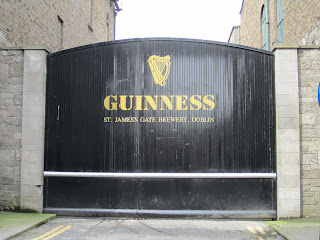Finally had a proper, adventurous and flavour-filled craft beer experience in Scotland - we visited the BrewDog pub in Glasgow. BrewDog is brewed further North, but they now own a handful of their own pubs in both Scotland and England, so that you have a good setting (with very knowledgeable and passionate staff) in which to sample BrewDog's wares.
To this point I hadn't sampled much BrewDog beer, primarily because it's quite expensive in Vancouver, and there are thankfully plenty of good options in the lower mainland's well-stocked private stores. I wasn't sure what I would think - were the punk theme and the extreme beers a gimmick, or would I encounter some great craft beer? Definitely the latter. On the surface, I'd call them a newer, smaller, Scottish Stone Brewing - the rhetoric and attitude are similar.
They had a nice tap list of their own beer to choose from, as well as a couple of guest taps and a huge bottle list featuring many well-known names in aggressive/exotic craft beer. (But no Canadian bottles that I could see.)
 |
| Let the games begin! |
We managed to sample everything on the chalkboard except the 5AM Saint, and only had a taste of the Chris from Stone Stout.
The pub is cozy and comfortable despite being utilitarian. And it provides board games to play in addition to a nice library of classic beer/brewing books to browse.
We even got to hear some live hipster rock-a-billy music - which is apparently the correct soundtrack for chess.
The quick and dirty run-down:
- Barrel Aged 7.7 Lager: apparently aged in FRESH oak barrels. I expected to be run over by sappy, green oak flavours, but this was spot-on - gentle woodsy/honey flavours instead.
- Punk IPA: delicious, big but not overweight. I had two full pints as palette cleansers between other beers.
- Zeitgeist: a very nice schwarzbier, richer than usual
- Libertine Black Ale: a Cascadian Dark Ale made with 100% Simcoe hops. I've really missed Simcoe on this trip (it caused flashbacks featuring Red Racer IPA) so I enjoyed this beer, even though there was a surprising lack of roasty/chocolately malt flavours. It was a hop showcase; ironically tasted much like a pale ale.
- Chris from Stone's Stout: a collaboration beer, a strong sweet & roasty stout. Great stuff - until you taste the Paradox Jura.
- Hardcore IPA: a remarkably drinkable and not-overly-sweet Imperial IPA. (Maybe a "Double IPA"?)
- Paradox Jura: the star of the evening, hands down. This was a massive, very sweet but very roasty and well-balanced stout, aged in Jura scotch whisky barrels. The barrels imparted a firm smokey, peaty character that married perfectly with the beer. Simply sublime. Like drinking a fine port... um... er... with a peat cigar? (Terrible analogy and totally incorrect, my apologies.) Why do so many North American brewers continue to wood-age stouts almost exclusively in bourbon barrels? (Availability? Trend?) All too often the bourbon barrel flavours do not marry well with the beer, and they go beyond adding some vanilla and caramel, creating sappy, woody flavours that are terribly out of place. The soft, smokey, peaty scotch flavours in this beer were amazing.
- Tactical Nuclear Penguin: my vote for best beer name ever. You'd be excused for thinking this was a gimmick beer, given that they ice distill a stout until it reaches 32% ABV. But I thought it was a complex, interesting beverage when served in a snifter (1 oz) and slowly sipped.
- Sink The Bismark: similar to the Penguin, but this one is made by ice distilling a double IPA until it reaches 42% ABV. Still interesting, but a bit of a miss for me. I think something this strong needs the complexity of concentrated malt and/or yeast flavours, but the distillation process makes this beer overwhelmingly bitter, which kind of stuns your palette. If you're a fan of big, hoppy IPAs, it's worth trying an ounce since it's pretty much the furthest you can conceivably push an Imperial IPA.
 |
| First up: Libertine Black Ale and Barrel Aged 7.7 Lager |
 |
| I heartily endorse this Jura barrel-aged stout |
 |
| Extreme closeup of Tactical Nuclear Penguin. Nice Legs. |
 |
| Closeup of Sink The Bismark. Seems innocent enough. |
I would say you can't leave Scotland without a visit to a Brewdog venue. Especially if, like me, your next stop is Turkey or some other equally-devoid-of-craft-beer destination. (Must hold on... until... judging the... National Homebrewers Competition... in June... ack...)









































